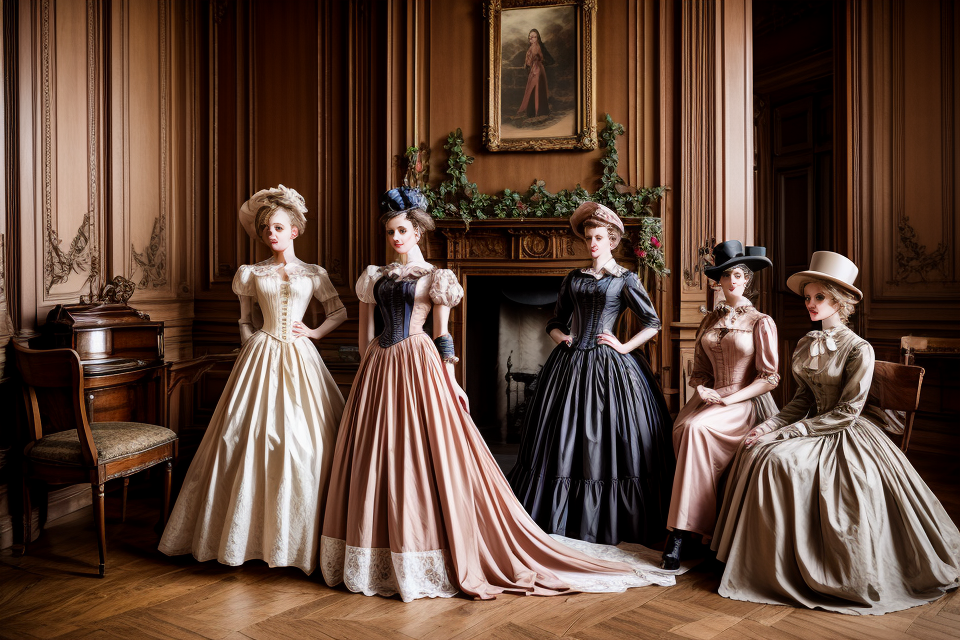
Fashion is an ever-evolving industry that has been around for centuries. It’s an art form that allows individuals to express themselves through clothing and accessories. But have you ever wondered who came up with the idea of fashion? The origins of fashion can be traced back to ancient civilizations, where clothing was used as a form of protection from the elements. However, it wasn’t until the 19th century that fashion as we know it today began to take shape. In this article, we will explore the history of fashion and the individuals who have contributed to its development. From designers to icons, we will uncover the fascinating story of how fashion became the multi-billion dollar industry it is today. So, get ready to discover the origins of fashion and the people behind this art form.
The origins of fashion can be traced back to ancient civilizations, such as the Egyptians and Greeks, who valued clothing as a form of self-expression and status symbol. However, the modern fashion industry as we know it today began to take shape in the 19th century, with the rise of industrialization and the growth of cities. It was during this time that designers and fashion houses began to emerge, and the concept of fashion shows and runway models was born. Today, the fashion industry is a global business, with designers, manufacturers, retailers, and consumers all playing a role in shaping the latest trends and styles.
The Evolution of Fashion: A Brief Overview
The Early Stages of Fashion
The Role of Culture and Society in the Development of Fashion
In the early stages of fashion, culture and society played a significant role in shaping the way people dressed. The clothing choices of individuals were often influenced by their religious beliefs, social class, and geographical location. For example, in ancient civilizations, people wore clothing that reflected their religious beliefs and rituals. In medieval Europe, the clothes worn by peasants and nobility differed significantly, reflecting their social status. Similarly, the clothing choices of people in different geographical locations were influenced by the climate and available materials.
The Influence of Religion on Early Fashion
Religion has been a significant influence on fashion since the early stages of civilization. In ancient Egypt, for example, people wore clothing that reflected their religious beliefs and rituals. Similarly, in medieval Europe, the clothes worn by peasants and nobility often reflected their religious beliefs. For instance, nuns wore clothing that reflected their religious vows, such as the habit, while priests wore clerical attire.
The Impact of Social Class and Status on Fashion Trends
Social class and status have also played a significant role in shaping fashion trends since the early stages of civilization. In ancient civilizations, such as Rome and Greece, clothing was often used to indicate social status. For example, only the wealthy could afford to wear fine fabrics and elaborate jewelry. Similarly, in medieval Europe, the clothes worn by peasants and nobility differed significantly, reflecting their social status. Peasants typically wore simple, practical clothing, while nobility wore more elaborate and expensive outfits.
The Role of Geographical Location in Shaping Fashion
Geographical location has also played a significant role in shaping fashion trends since the early stages of civilization. The clothes worn by people in different regions were often influenced by the climate and available materials. For example, in cold climates, people wore thick, warm clothing made from animal hides or furs. In hot climates, people wore lightweight, breathable fabrics made from natural materials such as cotton or linen.
The Emergence of Haute Couture and Fashion Designers
Haute couture is a type of high-end fashion design that emerged in the late 19th century. It involves the creation of custom-made clothing for individual clients, often using high-quality materials and intricate techniques. The emergence of haute couture was a significant development in the evolution of fashion, as it marked the beginning of the fashion designer as a recognizable profession.
The first couture houses were established in Paris, France, in the late 19th century. The most famous of these was the House of Worth, founded by Charles Frederick Worth in 1858. Worth was an Englishman who had trained as a draughtsman and had worked as a designer for a dressmaker in London. He moved to Paris and opened his own couture house, which quickly became popular among the city’s elite.
The rise of couture houses and fashion designers had a significant impact on modern fashion. These designers were responsible for creating new styles and trends, and their work was often featured in fashion magazines and photographs. The influence of haute couture on modern fashion cannot be overstated, as it paved the way for the development of the fashion industry as we know it today.
The Mystery Behind the Invention of Fashion
Theories and Speculations on the Origin of Fashion
The Theory of Functionalism
The Theory of Functionalism is one of the most widely accepted theories when it comes to the origin of fashion. According to this theory, clothing was initially invented for practical purposes such as survival and protection from the elements. In other words, early humans needed clothing to keep warm, to protect themselves from the sun, and to cover their private parts.
The Importance of Clothing for Survival and Protection
The importance of clothing for survival and protection cannot be overstated. In ancient times, the harsh climate and environment could be fatal if proper clothing was not worn. For example, in cold climates, people needed to wear thick fur coats to keep warm, while in hot climates, people needed to wear lightweight clothing made from natural fabrics like cotton and linen.
The Influence of Climate and Environment on Fashion
The influence of climate and environment on fashion is still evident today. Different regions have different fashion styles that reflect the local climate and environment. For example, people living in cold climates tend to wear heavier clothing made from thicker fabrics, while people living in warmer climates tend to wear lighter clothing made from breathable fabrics.
The Theory of Symbolism
The Theory of Symbolism suggests that clothing was initially used as a form of expression and identity. According to this theory, early humans used clothing to express their social status, personal beliefs, and cultural identity. Clothing was also used as a way to differentiate between different groups of people, such as nobles and peasants.
The Use of Clothing as a Form of Expression and Identity
The use of clothing as a form of expression and identity is still evident today. People use clothing to express their personal style, cultural identity, and social status. For example, certain clothing items may be associated with a particular subculture or fashion trend.
The Influence of Culture and Society on Symbolic Meanings
The influence of culture and society on symbolic meanings is also still evident today. Different cultures and societies have different symbolic meanings associated with certain clothing items. For example, in some cultures, white is a symbol of mourning, while in other cultures, it is a symbol of purity. Understanding these symbolic meanings is important when studying the history of fashion and how it has evolved over time.
The Search for the First Fashion Designer
The Legend of Saint Laurent
The Life and Legacy of Saint Laurent
The Impact of Saint Laurent on Fashion History
The Mystery of the First Fashion Designer
The Search for the First Fashion Designer
The Influence of Ancient Civilizations on Fashion
The Influence of the French Revolution on Fashion
The Rise of Haute Couture in the 19th Century
The Emergence of Ready-to-Wear in the 20th Century
The Globalization of Fashion in the 21st Century
The search for the first fashion designer is a fascinating topic that has intrigued historians and fashion enthusiasts alike. While there are many theories and legends surrounding the origin of fashion, there is no definitive answer to who came up with the idea of clothing design. However, there are several notable figures who have left an indelible mark on the fashion industry and whose contributions have shaped the way we dress today.
One of the most legendary figures in fashion history is Saint Laurent. Born in 1936 in Oran, Algeria, Yves Saint Laurent was a French fashion designer who became known for his innovative and influential designs. He started his career at the age of 17 when he won a design competition sponsored by the International Wool Secretariat. This launched his career as a fashion designer, and he went on to become one of the most successful and respected designers of his time.
Saint Laurent’s impact on fashion history cannot be overstated. He was a true visionary who challenged traditional norms and conventions and introduced new styles and trends that transformed the fashion industry. His designs were characterized by their simplicity, elegance, and sophistication, and he was known for his ability to anticipate and reflect the changing social and cultural landscape of his time.
While Saint Laurent is widely recognized as one of the greatest fashion designers of all time, the search for the first fashion designer remains a mystery. Some historians believe that clothing design may have originated as a functional necessity, such as protecting the body from the elements or signaling social status. Others suggest that fashion may have originated as a form of self-expression or as a way to communicate cultural values and beliefs.
Regardless of its origins, the influence of fashion on society cannot be denied. From ancient civilizations to modern times, fashion has played a crucial role in shaping our identity, expressing our values, and reflecting our culture. The fashion industry has also had a significant impact on the global economy, generating billions of dollars in revenue each year and creating employment opportunities for millions of people around the world.
In conclusion, the search for the first fashion designer remains a mystery, but the impact of fashion on society is undeniable. From the influence of ancient civilizations to the rise of haute couture and ready-to-wear, fashion has played a crucial role in shaping our identity and reflecting our culture. As the fashion industry continues to evolve and adapt to changing social and cultural norms, it will be interesting to see how fashion designers continue to shape and influence our world.
The Enduring Legacy of Fashion
Fashion has been a part of human history for centuries, with styles and trends constantly evolving. Despite its long and rich history, the origins of fashion remain a mystery, and it is difficult to pinpoint exactly who came up with the idea. However, it is clear that fashion has had a lasting impact on society and culture, shaping the way people express themselves and influencing economic systems around the world.
The Impact of Fashion on Society and Culture
Fashion has played a significant role in shaping society and culture throughout history. From ancient civilizations to modern times, fashion has been used as a form of self-expression, allowing individuals to communicate their personal style and identity to the world. Fashion has also been a reflection of social and political movements, with certain styles and trends becoming synonymous with particular time periods and cultural shifts.
The Role of Fashion in Identity Formation and Self-Expression
Fashion has long been a means of self-expression, allowing individuals to communicate their personal style and identity to the world. From the clothes we wear to the accessories we choose, fashion choices can reveal a great deal about a person’s personality, values, and even social status. Throughout history, fashion has been used as a form of rebellion, with subcultures and countercultures using fashion to differentiate themselves from mainstream society.
The Economic Impact of Fashion on the Global Industry
Fashion has also had a significant impact on the global economy, with the industry generating billions of dollars in revenue each year. From high-end luxury brands to fast fashion retailers, the fashion industry employs millions of people around the world and is a major contributor to local and national economies. The industry is also heavily influenced by technology, with advancements in textile production, e-commerce, and social media all playing a role in shaping the fashion landscape.
The Future of Fashion
As the world continues to evolve, so too does the fashion industry. With the rise of social media and e-commerce, fashion has become more accessible than ever before, with consumers able to shop from the comfort of their own homes. Additionally, sustainability and ethical practices are becoming increasingly important in the fashion industry, with consumers and designers alike looking for ways to reduce waste and minimize environmental impact. As the industry continues to evolve, it will be interesting to see how fashion will shape and be shaped by society and culture in the years to come.
FAQs
1. Who came up with the idea of fashion?
The concept of fashion has been around for centuries, and it’s difficult to pinpoint a single person or group of people who came up with the idea. However, historians believe that fashion originated in ancient civilizations such as Egypt, Greece, and Rome. These cultures were known for their intricate clothing and accessories, which were often worn by the wealthy and powerful.
2. How has fashion evolved over time?
Fashion has evolved significantly over time, and it has been influenced by a variety of factors such as social, cultural, and economic changes. In ancient times, fashion was primarily used as a way to display wealth and status. Over time, fashion became more accessible to the general population, and it began to reflect the changing tastes and preferences of society. Today, fashion is a global industry that encompasses everything from haute couture to fast fashion.
3. What role do designers play in the fashion industry?
Designers are the creative minds behind the fashion industry. They are responsible for conceptualizing and creating new clothing and accessory designs, as well as determining the overall aesthetic direction of a brand. Many famous fashion designers, such as Coco Chanel and Christian Dior, have become iconic figures in the industry and have had a significant impact on the way people dress and express themselves.
4. What influences fashion trends?
Fashion trends are influenced by a variety of factors, including social and cultural changes, celebrity culture, and the media. The fashion industry is highly responsive to changes in consumer preferences, and designers and brands must stay up-to-date with the latest trends in order to remain relevant. Additionally, technological advancements and innovations in textiles and materials have also played a significant role in shaping fashion trends over time.
5. Is fashion art?
There is ongoing debate about whether fashion can be considered a form of art. Some argue that fashion is a form of expression that requires creativity and technical skill, while others believe that it is simply a commercial industry designed to sell products. Regardless of whether or not fashion is considered art, it has certainly had a significant impact on culture and society throughout history.


